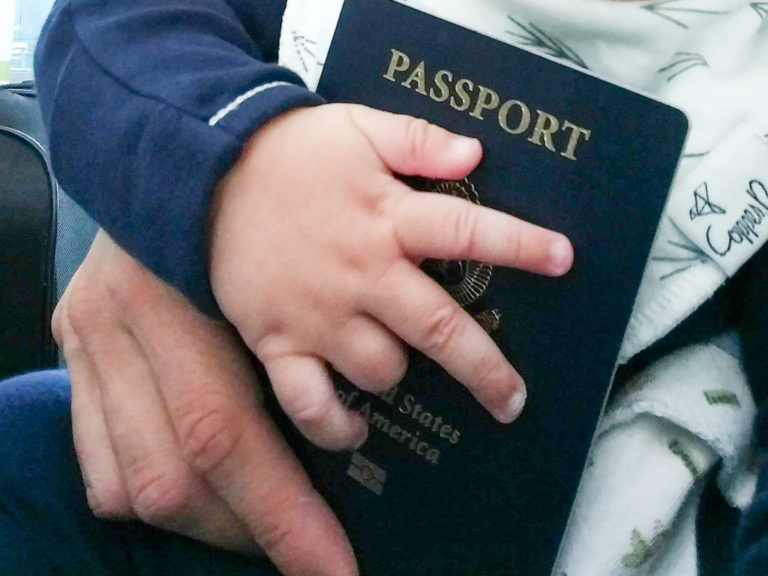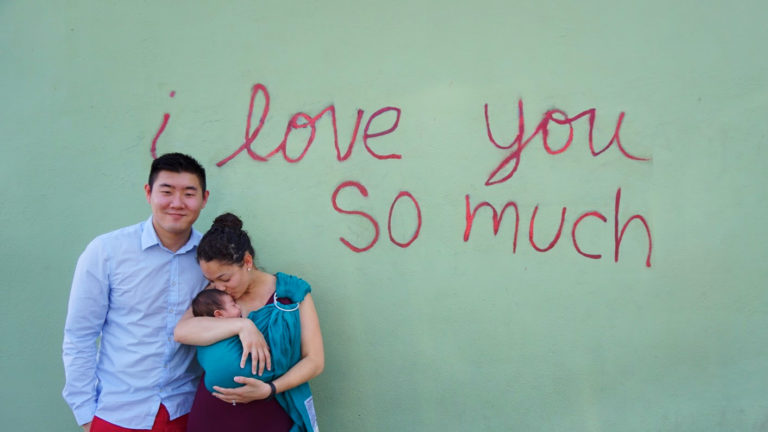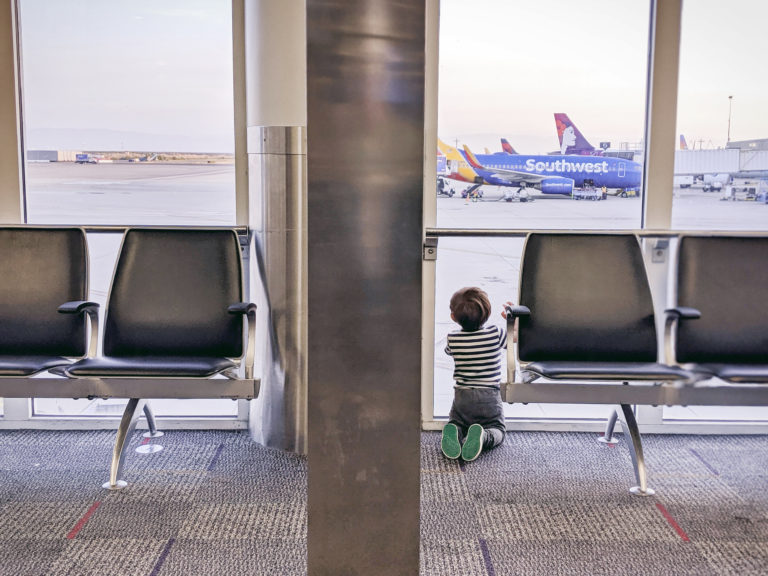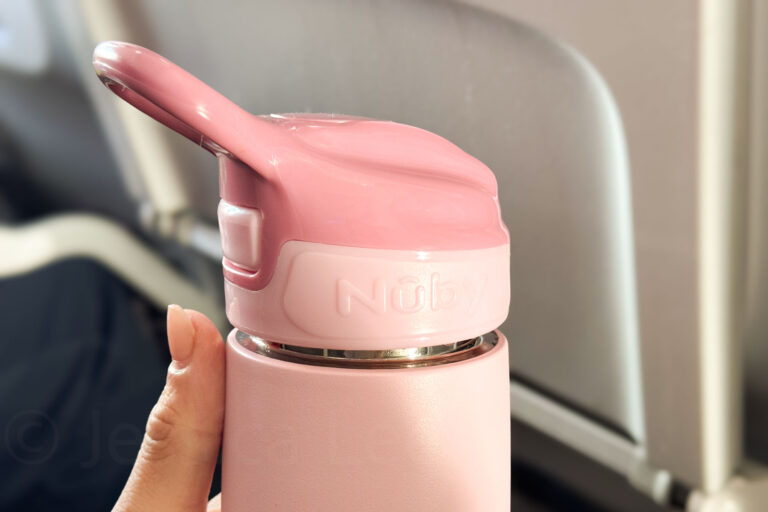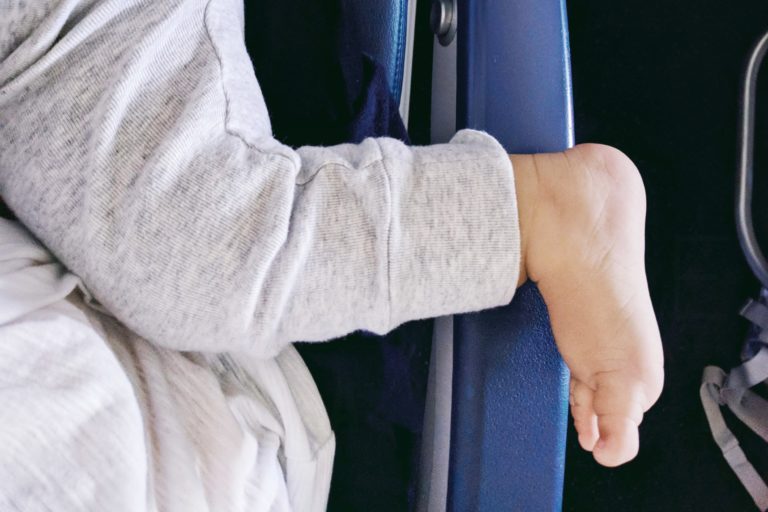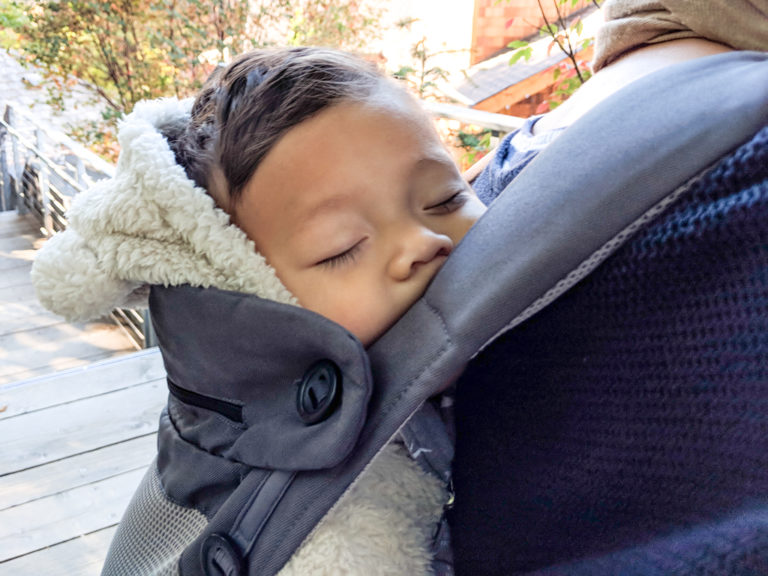How to Master a Long Haul Flight with a Baby
Are you thinking of flying halfway around the world with a baby? Gulp! But don’t panic, I don’t want to scare you. However, I do want to prepare you. Preparation is key for traveling on a long haul flight with a baby.
After several long haul flight experiences with my three children as babies, I want to pass on some advice. These are things we learned along the way that I wish we knew from the start. Let’s get into long haul flights: what you should know about booking your baby’s ticket, documentation, seat options, packing, tips, and how to survive a long flight with a baby.
Jump to: FAQs, Booking, Preparing, Airport, in-Flight Tips, Troubleshooting
In a rush? Pin this or email it to yourself to read later! (Psst! Use the buttons at the very top or bottom of this post for ease.)
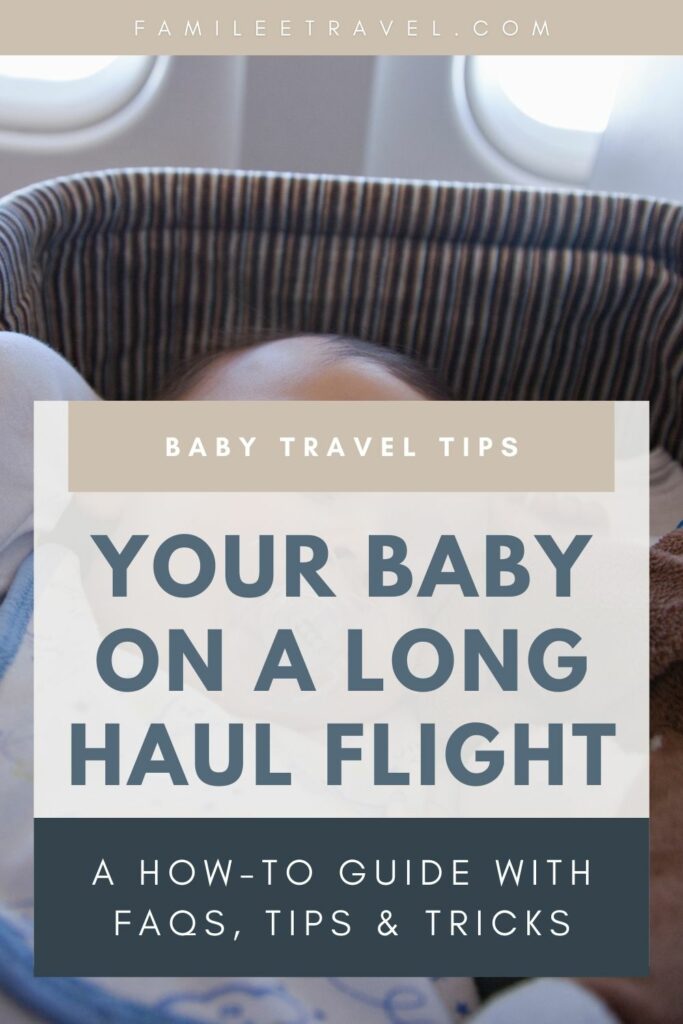
My long-haul babies
With my first baby, I was more cautious of diving fully into long haul travel and we took more trips domestically or to closer international destinations. For his first big international trip, we logged 16 hours from Houston, Texas to Tokyo, Japan when he was 7 months old. It was tiresome but not terrible. I loved Japan and would easily endure an exhausting flight for the travel experience.
With our second baby, we planned a round-the-world trip that included several long flights when he was 6-8 months old. This included a 14-hour long-haul from Panama City, Panama to Istanbul, Turkey. Next from Cairo, Egypt to Singapore for 13 hours, and later 11 hours from Fiji to Los Angeles, California. These trips were with our 2.5 year old toddler, and managing a toddler on a long haul was absolutely more challenging than the baby.
Our third baby had medical complexities that required us to stay home until she was stable. Once she got the clearance from her cardiologist she was a toddler, and then we took her on her first long haul to Seoul.
What is a long haul flight?
What’s a long-haul? Definitions vary slightly by country and airline but typically a long-haul flight is a non-stop flight with a duration of 6-12 hours, and anything over 12 hours is considered an ultra-long-haul flight.
Now, how do you survive so many hours in such a tiny space with a little one? Keep reading, I promise it is possible!
Affiliate Disclosure: Familee Travel contains affiliate links and is a member of the Amazon Associates Program, we may earn commissions from qualifying purchases at no additional cost to you.
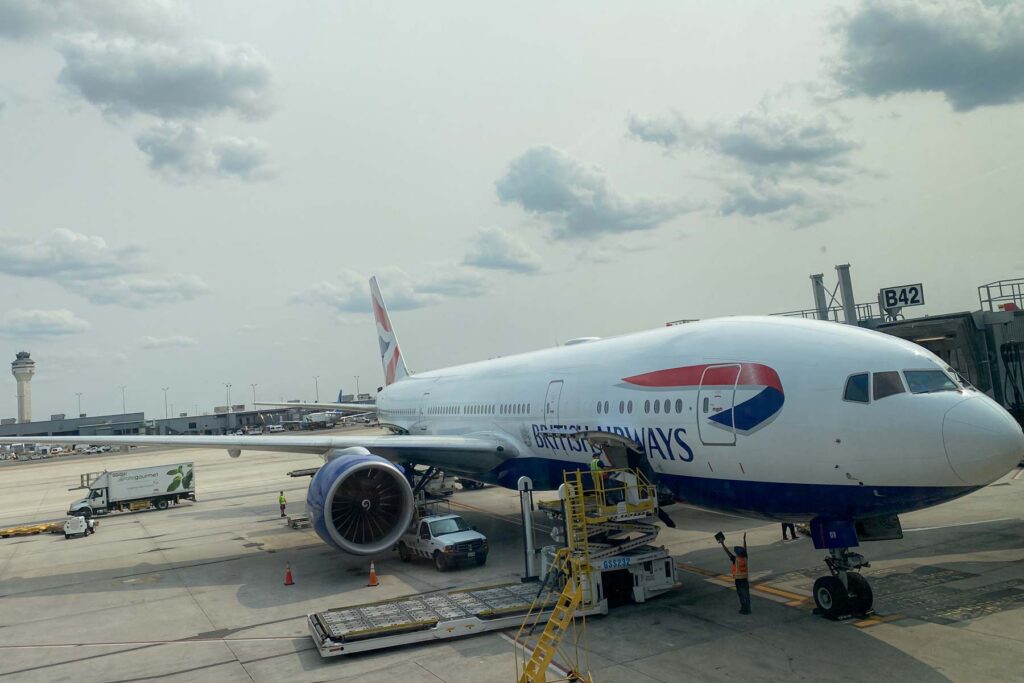
FAQs: What you should know about babies on long flights
Can you take a baby on a long-haul flight?
Yes, you can bring a baby on a long haul flight. Flying on commercial flights is open to the public which includes babies. There are no specific restrictions for babies on any type of commercial plane or flight.
However, your baby will need a passport to fly if it is an international flight (as most long hauls are). Getting a baby’s first passport takes time, so you must factor this into your travel plans.
What is the best age to take a baby on a long flight?
There is no universal magical best age to take a baby on a long flight. Every baby, every parent, and every family is a little bit different and therefore their travel and flight experiences will vary.
Generally speaking, the younger the baby the easier they are to travel with. However there are plenty of caveats to this statement, and it is not true for everyone and every baby.
Everyone will have a different opinion about how early is too early to travel with a baby. And every baby has a different temperament which can be a big factor in your flight experience.
When babies become mobile, it can become more challenging to entertain them in a small airplane seat for an extended period. So some parents think it’s ideal to take a baby on a long flight before they’re mobile.
From my experience, I think between 5-8 months is an extra sweet spot for traveling long haul with a baby. It is still doable outside this window, but there could be more challenges.
On the other hand, some parents prefer the experience of traveling long haul with even younger babies when they mostly only sleep or eat.
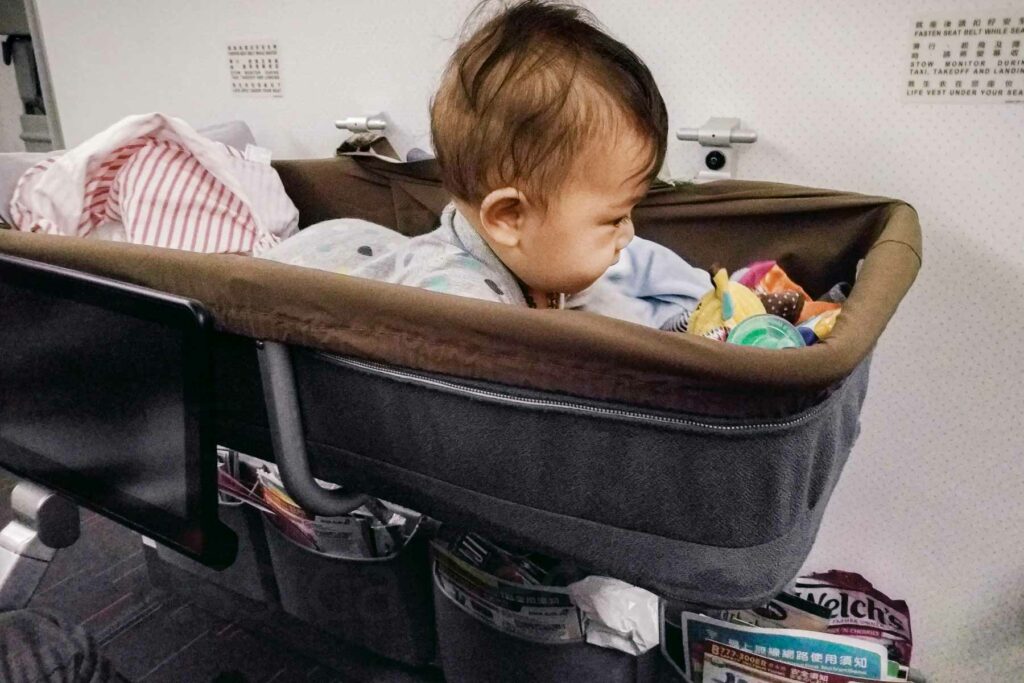
Can a baby travel internationally without a passport?
No, a baby cannot take a flight and travel internationally without a passport.
If you are traveling with your baby who is a US citizen, and you drive to Canada or Mexico, it is possible to only bring their birth certificate.
If you fly internationally, however, no matter the distance or age of your baby, they require a passport.
What age do babies fly free internationally?
A baby cannot fly for free on an international flight. Yes, even if they sit on an adult’s lap and do not occupy their own seat, you still have to pay for a ticket for your baby. It might be less expensive though.
- For international flights, to book a baby as a lap infant, you have to pay a portion of an adult ticket (somewhere around 10%) plus applicable taxes and fees. This is the case if the baby is 9 months old, 18 months old, and even if they’re only 2 weeks old.
- If you want to book them their own seat, then you have to pay for a full, or nearly full, fare regardless of their age.
Sometimes parents are confused or surprised to learn you have to pay for a baby’s international flight ticket. This may be because babies under the age of 2 can fly free as a lap infant on domestic US flights, however, the rules and costs are different for international flights.
If you want to reserve a seat for your baby, then you need to purchase them their own ticket regardless of their age. Some airlines, but not all, offer slightly discounted fares for children.
If you want to guarantee the use of their car seat on board, then you need to buy them a seat. Sometimes the flight attendants might let you use an extra open seat for your baby’s car seat if the flight is not full, however, going this route would be by chance and not guaranteed.
Where do babies sleep on long haul flights?
Babies can sleep on a long haul flight in a variety of places – on you, a partner, a family member, a baby carrier, a car seat, a plane seat, or an airplane bassinet. Your options will vary depending on which type of ticket you purchase for your baby.
If you buy your baby a lap infant ticket, then you can hold them in your arms or with a carrier to sleep. Bassinets are available on some long flights for infants, but they are extremely limited. Keep reading for further details about airplane baby bassinets.
If you buy your baby their own economy ticket, then, you can bring their car seat on board and install it in their seat for them to sleep in it. For business class and first class, car seats are not always allowed, but sometimes they are. It depends on the airline and the specific plane.
If you are not bringing your baby’s car seat, you can purchase an inflatable foot rest pillow or a special inflatable bed baby pillow to fill in the gap between the seats and make a makeshift bed for them to sleep.
Some parents purchase a business or other lay-flight seat option for more space to be able to co-sleep with their baby on a long flight.
More recently, a few airlines have offered a new option. You can purchase an entire row of economy seats and they have a special attachment or pad to cover them and turn the row into a makeshift bed. This way an adult can lie down with a child sideways more comfortably than only in their upright seats.
Air New Zealand pioneered the idea with its SkyCouch. Since then, some other airlines have followed suit with their own products, like All Nippon Airways’ Couchii, and Lufthansa’s Sleeper Row though this one doesn’t appear as wide and may only be appropriate for a single traveler.
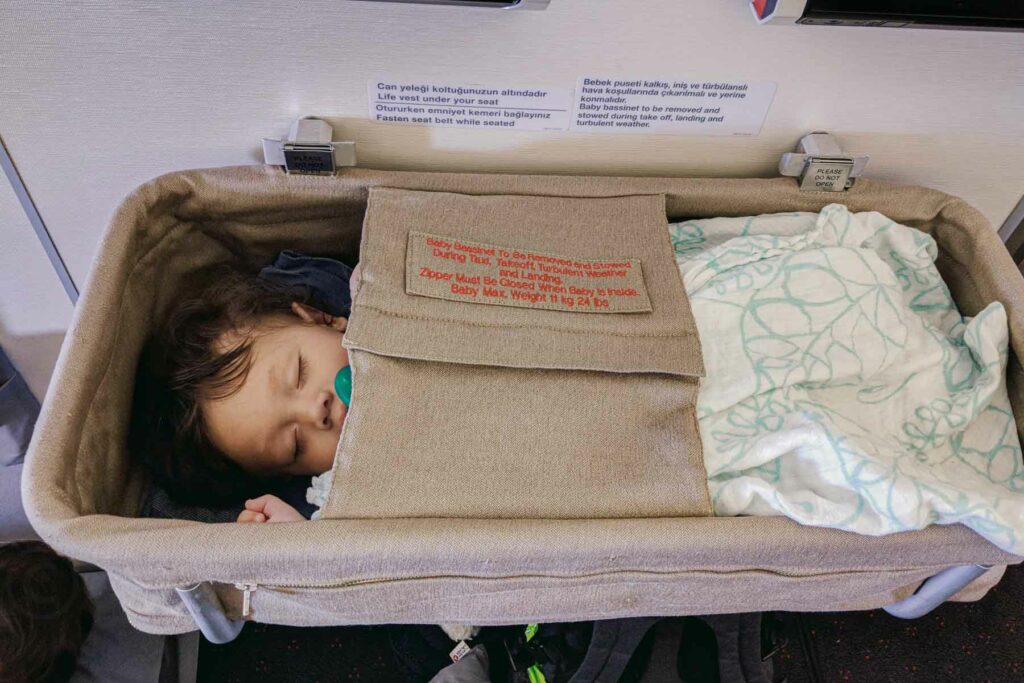
Your Guide to a Long Haul Flight with a Baby
- Booking a Ticket for Your Baby
- Long Flight Prep and Packing Tips
- Tips for at the Airport
- Long Haul In-Flight Tips for Parents
- Tips for Troubleshooting Tears
1. Booking a Ticket for Your Baby
When you head to an event, board a train, or visit an amusement park, babies are typically free and do not require tickets. So we get used to babies being exempt from all sorts of things since they’re so little.
And you may even think they don’t need the same documents as an adult for flights since they can fly for free domestically. But this is not the case for international flights and traveling between countries.
Consider the below aspects and tips when you’re ready to book your baby’s international trip.
Get paperwork in order
- Yes, your baby needs a passport for an international flight.
- Yes, your baby needs a ticket for a long haul flight.
- No, your baby does not need Global Entry.
Paperwork and documents are an essential piece of international travel, even for a baby.
Passport
Make sure you apply for their passport in time. Some international flights require you to add all traveler’s passport numbers when you book the flight. Others allow you to wait until check-in.
If yours requires the passport number at booking and you do not yet have your baby’s passport, you can put a temporary placeholder number (make it up), and then change it later once you have the official document.
Forms & Visa
In addition, double check your destination country’s entry requirements in case there are additional paperwork, visa, or other requirements necessary to fulfill ahead of arrival. These requirements vary depending on what country issued your passport, what country you’re traveling to, as well as your length and reason for travel.
Letter of Consent
If you are traveling solo with your baby without their other parent, if applicable, then it’s a good idea to bring a letter of consent. This letter should be written by the other parent stating they are aware and allowing you to bring your child out of the country.
Ticket
Even infants traveling on a lap not occupying a seat still require a ticket. Some parents assume their baby traveling on their lap does not need a ticket, but this is not the case. They need a ticket, the airline needs their information (e.g., name, birthdate, passport details), and you still have to pay a portion of the fare and taxes as well.
Sometimes they’ll allow you to add your baby on the reservation as a lap baby at check-in, but it’s not really worth the risk and wait. It’s better and safer to call in advance and add them to your reservation early.
Global Entry
Global Entry is one of the US’s Trusted Traveler Programs. It is not required for adults or babies for international travel. However, if a parent has Global Entry and wants to go through the Global Entry queue with their baby, then the baby also needs to be enrolled in the program.
Plan your party
Taking a baby on a long haul is no small feat. If you are privileged to have able and trusted help, extra funds, and flexibility, consider traveling with another adult. Some parents have to travel solo with a baby on a 15 hour flight. My hats go off to these parents, nothing but respect.
If it is in anyway feasible, I would recommend traveling with at least one additional adult that is able to help with the baby. Try to arrange your travel plans to work with your partner, parent, or other adult’s schedule so you can travel together. Being able to share duties and trade off taking care of the baby can make a big difference in surviving a long haul with a little one.
Purchasing the ticket
Now you’re ready to book your flight. What type of ticket should you book for your baby?
You can choose from two types of tickets: a lap baby ticket or a seated passenger baby ticket. Within these, there are additional options to choose from.
Seated Baby
If you’re able to spend the extra money, buy your baby their own seat. The extra space will be worth it.
When you have a designated seat for your baby traveler, then you can use their car seat, or bring another special airplane bed for babies. When they have their own seat, you are still allowed to pick them up to hold, comfort, or feed them. They do not need to be strapped in their seat for the entire flight.
If you choose to bring their car seat on board, then you will have a safe, familiar, and secure place to set them down and sleep. The Federal Aviation Administration (FAA) and the American Academy of Pediatrics (AAP) recommend that a baby be secured in their car seat when traveling on a plane.
Please note car seats must be installed in window seats as they are not allowed to block the way of another passenger in case of an emergency. There are very rare exceptions to this rule.
While it is recommended children under 40 lbs use a car seat when flying, it is not required.
Another option is to bring a special inflatable baby airplane bed designed specifically to fill in the gaps between airplane seats to create a larger flatter surface for a baby to lie down. There are inflatable footrests that fill in the gap as well, and I’ve draped a blanket across to let my kids lie down and this worked well. Now there are even more robust products on the market like these baby beds.
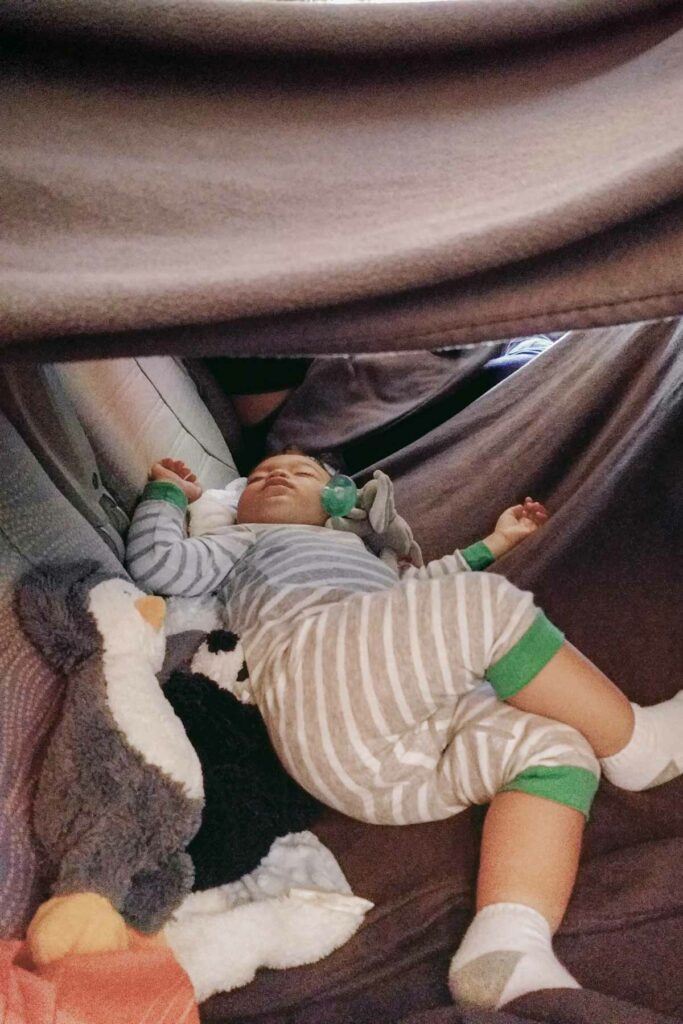
Lap Baby
You should be able to purchase your baby a lap infant ticket for any class of the plane – economy, business, or first class.
You are unable to travel with a lap baby in the emergency exit row seats, but otherwise, you should be able to book any other open seats.
A special option offered to lap infants is a baby bassinet.
I have a love/hate relationship with airplane baby bassinets. They’re these clever little bassinets that hook to the plane’s wall and then your baby has a bed to lie down in on the flight.
They only accommodate babies up to a certain weight and length (varies by airline). You can request one for a lap infant and typically don’t have to pay extra for this.
Make sure you call well in advance of your flight to reserve the bassinet because there are only a few available per flight.
Pros
- The bassinet is great to give your arms some relief on a long flight. 9 hours of holding a baby is tiring.
- You get to sit in the bulkhead seats as this is the only place the bassinets attach, so you get extra legroom which is extra floor play space for your baby.
- If your baby stays asleep in it, you have more freedom and space to get up, eat with two hands, sleep, etc.
Cons
- Typically the armrests in the bulkhead seats do not move, and the trays/screens might fold out from the armrests. On regular flights, we always have our armrests on the plane up so we can move and share seat space.
- Every airline, except one, wanted us to pick up the babies whenever the seat belt sign came on for a bit of turbulence. For some flights, this was very frequent on/off for little bumps. I know safety is most important, but when you finally get a baby asleep you try to keep them asleep not pick up, put down again and again.
Airplane baby bassinets are a great idea, and I do recommend trying one out for your first long-haul flight with a baby at least to decide if they work well for your family.
2. Long Flight Prep and Packing Tips
Preparation is key to a smoother long haul flight experience with a baby. How you plan, pack, and prepare for your flight can make all the difference.
Long-hauls are different since you’re in the air for so long. If you forget something or have a problem on a short flight you can probably get by until you land. On the other hand, imagine if your baby spits up all over your shirt and you still have 10 hours to go before you land.
Consider these tips to help you plan and prepare for a long haul flight with a baby.
Pack extra clothes and gear
Bring a change of clothes for everyone. You don’t want to stay in a shirt your baby blew out on only 2 hours into a 14-hour flight. Bring pajamas, extra shirts, plenty of diapers, etc.
Most airlines still include free checked luggage on a long-haul flight, so cabin bin space is plentiful as everyone isn’t trying to crowd all their stuff on board.
Don’t overpack where you can’t manage, but do make sure you have enough extras to keep everyone comfortable in case of any big messes.
Bring sleep accessories
Pack the special blanket, stuffie, or lovie. If it’s small enough, bring any comfort item to help your baby sleep on the plane as if it’s nighttime not only a nap.
Bring a portable white noise machine. The plane has natural white noise, but there are also beeps, announcements, and talking that can cause disruptions. A mini white noise machine can help block out those interruptions to keep your baby asleep.
A blackout cover can also be helpful. It is NOT fun if you finally get a baby asleep and then the lights turn on, they start pushing carts and the plane starts buzzing for dinner. The CoziGo is one of the most clever baby travel items I’ve come across. It’s like a mini breathable blackout tent specially sized to fit over airplane bassinets and strollers, plus it folds up really small.
We draped muslin blankets and nursing covers, which worked in a pinch (sort of), but it was tougher to make these stay up and off our baby’s face. The CoziGo pitches and stays up like a tent which makes all the difference.
If your child will have their own seat, an inflatable footrest pillow can be an easy and cheap way to keep them more comfy. You blow it up and it fills in the floor space gap between the seats and is level with the seat thereby extending it. If the child is young enough or small enough they may even be able to lie flat this way. Note, some airlines do not allow these footrests so check your airline’s policy.
Bring books and toys
Bring some items you know will entertain your baby. Also, consider packing some new things they haven’t played with yet to increase their excitement and attention. This is going to depend a lot on your baby’s age. Younger babies require very few items for entertainment, while older ones may need more stimulating plane toys.
Long-haul planes typically have built-in screens at each seat and offer a kid-friendly section of entertainment. This can be helpful for toddlers and older kids, but may not work well as a distraction or even be appropriate for a baby. You should be able to turn the screen off if you prefer.
Use packing cubes or small bags
To keep your things organized and easier to access, use packing cubes, Ziploc bags, or another type of container to segment your stuff. I like using these small clear pouches for little items so I can see what’s inside them without opening everything.
I group different items for different needs. This way, I can grab a pack or bag and know it will have everything I need rather than fishing around the larger backpack for each individual item.
For example, I’ll put diapers, a pack of wipes, and diaper cream in a large Ziploc bag (or a reusable changing pad cover and travel bag). When my babies were really young, I would pack a few disposable changing pads (aka chucks pads) to put down when dealing with a blow out.
I’ll have a small packing cube filled with little toys. And another bag holding a change of clothes. I don’t want to be digging around with one hand looking for socks, a pair of pants, and a shirt in the dark while simultaneously trying to hold a squirming baby. When I need an outfit change, I’ll pull out that one packing cube.
Pick your luggage carefully and practice
Babies are not the lightest travelers, however, you want to make sure you plan your packing and luggage pieces wisely. Plan it out and practice to make sure you’ll be able to manage!
Having to struggle through the airport is not fun, and doesn’t set a great tone for your trip. Streamline your packing as much as possible. Consider what pieces, sizes, and factors of different luggage you will need and whether it will all work well together. Will you still have a free hand or two to hold your baby? Backpacks are better to travel with than shoulder bags since they’re more stable on your back.
For many trips, I’d have a backpack on my back, my baby in the baby carrier on my front, pushing a toddler in a travel stroller, and rolling a suitcase with one hand. Are you able to push your stroller with one hand or do you need two? Does your suitcase wheel easily enough?
Also, don’t only think about getting to the airport and checking in for your flight. Remember all the other transfers you’ll be making and needing to do this with all your luggage – leaving the airport, any public transportation or taxis, and walking?
Plan for baby’s milk needs
Is your baby nursing or bottle feeding? Are you using formula or expressed breastmilk? Since long haul flights are, well…long, you need to plan for multiple feedings.
Make sure you will have everything you need for your baby’s feeding and eating needs. You are allowed to bring baby bottles and milk for a baby on board, but make sure you’re aware of the specific rules and guidelines.
You can bring baby snacks, such as teething crackers, cut-up food from home, and baby pouches through security and on board.
Airlines usually have some baby food jars or pouches to offer infant babies.
Some nursing mothers find it helpful to bring a nursing pillow when traveling with a breastfeeding newborn.
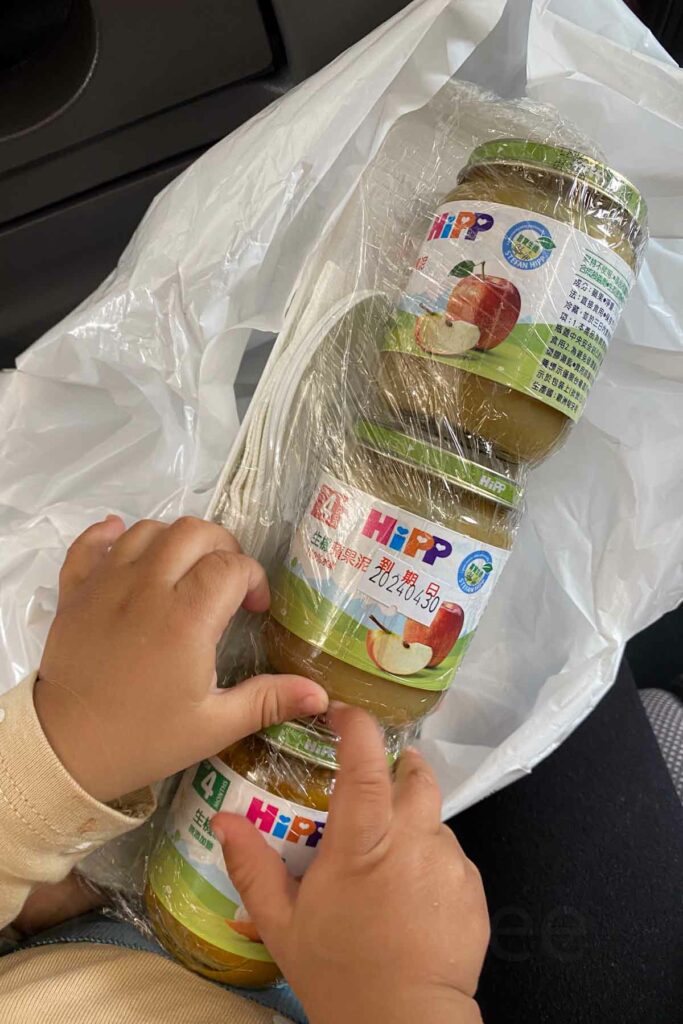
Dress in layers
Sometimes they’re hot and sometimes they’re cold. It’s tough to predict and expect a consistent temperature on a flight. Your best bet is to dress yourself and your baby in layers for a long flight.
Make sure you have appropriate clothing pieces that will be comfortable if the plane gets toasty, and also if it gets chilly.
Get some sleep
This is a tip for before your long-haul flight. Try to be well-rested heading into your long-haul flight with a baby, because you will unlikely get enough sleep during the flight itself.
3. Tips for at the Airport
You’re getting closer, time to head to the airport. For long international flights, you’ll need to arrive at the airport extra early. This should allow you plenty of time to check in, get your luggage sorted, go through security, and passport control, get ready, change, and do anything else you need to do to get ready.
Ask for help
Certain airports have curbside check-in counters or other attendants that can assist you with your baggage and getting through the line. In several destinations worldwide, when airport staff see us with so many kids they’ve helped us along and go to a special line only for families. Other times, there are helpful travelers willing to lend their extra hand when they see you traveling with a baby. Take the help!
Check-in at the counter
Some of the airport kiosk systems have been updated and allow you to check a lap baby in yourself; however, many still require you to work with an airline attendant at the desk for check-in. If you go to the counter, you can also ask them to double-check your bassinet request (if applicable) and discuss any seat changes.
Know your baby’s milk allowances
You are allowed to bring breastmilk, formula, and other liquids for your baby through airport security. You can bring bottles, wipes, baby pouches, food for your baby, and other necessary baby items to take care of your child in flight.
Don’t be afraid to ask for a supervisor or show the TSA agent the TSA website guidelines on baby products if you’re getting pushback.
Grab last-minute items
Did you realize on the drive over you forgot something? If you’ll need it for the flight, check out the airport shops. Long-haul flights usually leave from international terminals with more shopping and dining vendors than domestic terminals.
Since you’ll be on the plane for so long, you want to make sure you’ll have everything you need to stay content and comfortable.
Look for the play space
Many of the largest airports have indoor play spaces for children. If your baby is older, and you have the extra time, look for the playground. Let your baby roll, crawl, and get some last wiggles out before your flight.
Change baby before boarding
Most, if not all, of the restrooms on your plane should be equipped with changing tables. If it’s not clear, ask any flight attendant to tell you which restrooms have changing tables.
In my experience, jumbo jets used for long hauls are slightly nicer and a little more spacious, but, still, they’re not the ideal setup for changing a baby.
Take advantage of more space in the airport terminal, and change your baby one last time before you board.
Board early or last
Boarding timing is up to your personal preference and perhaps your baby’s personality. Many airlines offer a special window for families to board with young children earlier than the general boarding. The timing varies by airline.
If it would help you to get on board with extra time to get setup, then board during this window. If you think it would be better for your baby to have extra time to stretch out, roll, or crawl around before being trapped on the plane, then consider staying at the gate and board at the end.
Another option is to send one adult to board earlier with as much gear as they can manage and have another adult stay back with the baby until the last minute.
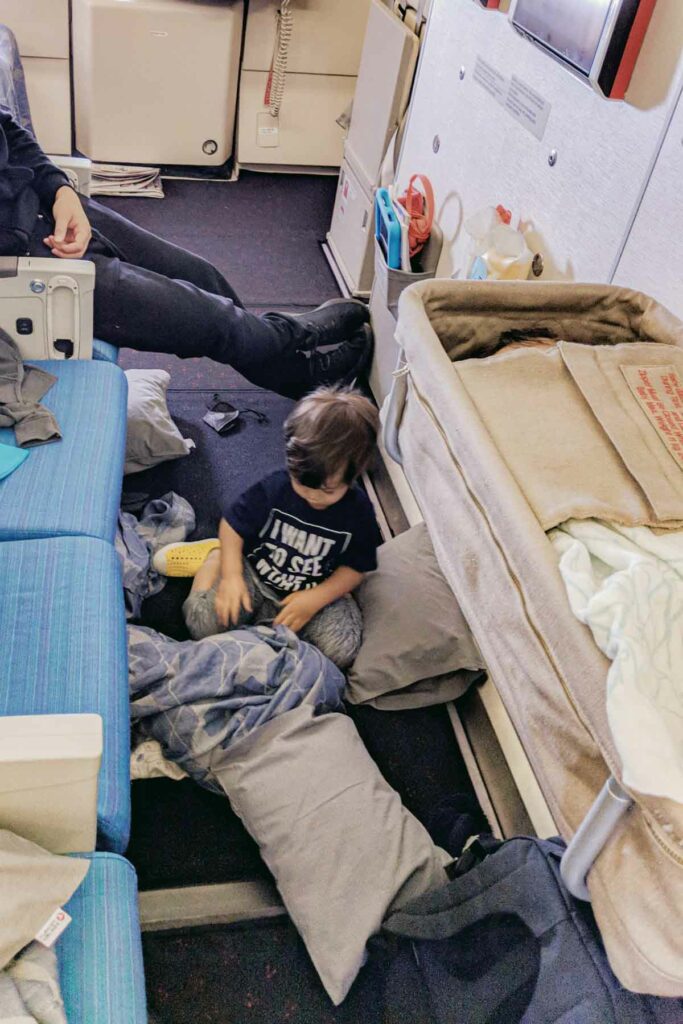
4. Long Haul In-Flight Tips for Parents
Alright, you’ve prepped and packed and now are ready to take on a long haul flight with a baby. You’re ready for this, you’ve got it. Wahoo, let’s go!
Get set up
For international flights, the plane boards earlier than for domestic flights. This means you have more time to get situated.
Use this extra time to install your baby’s car seat if you’re bringing it on board. Take out anything you will use during and shortly after take-off, such as your baby’s bottle.
We prefer to store as many bags above as possible on long-haul flights. Since the economy seats are tight and you’re on board for so long, it’s better to have the extra floor space if possible.
You’ll still be able to access your bags, but I try to take out some essentials and most-used items and store them in the back pocket or on the ground underneath the seat in front of me. Once you’ve reached a certain altitude and stability, you’ll be allowed to stand up and retrieve additional items from your carry-on bags that you stored above your head.
Keep in mind, if you’re in the bulkhead row (which will be the case if you have a baby bassinet) then you cannot keep anything or any bags on the ground in front of you during take off or landing.
I like to always keep at least 2 diapers and a pack of wipes in the seat pocket to have ready to go when a change is necessary.
Note, if your baby is traveling as a lap infant, some non-US-based airline carriers provide the parent holding a lap baby with a special seat belt attachment. It’s just another separate seat belt with an extra loop. You thread the adult seat belt through it and then it clips around your baby like the regular seat belts. The flight attendants will require that you use it for take-off and landing.
Feed or offer a pacifier for take-off and landing
During take off and landing the pressure change can be a lot for a baby’s ears. For some, it doesn’t bother them at all, and others are more sensitive.
To minimize the pressure and help them acclimate to the change, you can nurse them, give them a bottle, or even a pacifier should help.
Switch off caretaking duties
If you’re traveling with a partner or another adult, make a plan to divvy up and switch off on baby duty. One adult has baby duty for the first 3 hours, then the other for the second 3 hours, etc., or however, will work for your family.
Taking care of a baby on an extra-long flight can be exhausting, and might be too much for one adult. One parent should try to rest and recharge a bit while the other handles the baby and then switch.
Introduce toys slowly
You’ve got a lot of hours ahead of you, make sure to pace yourself. Try to introduce their plane toys and distraction items slowly, one by one.
When they need it, offer them one toy to play with and wait until they’re done with it before introducing another activity or toy. Resist dumping a pile of toys in their lap.
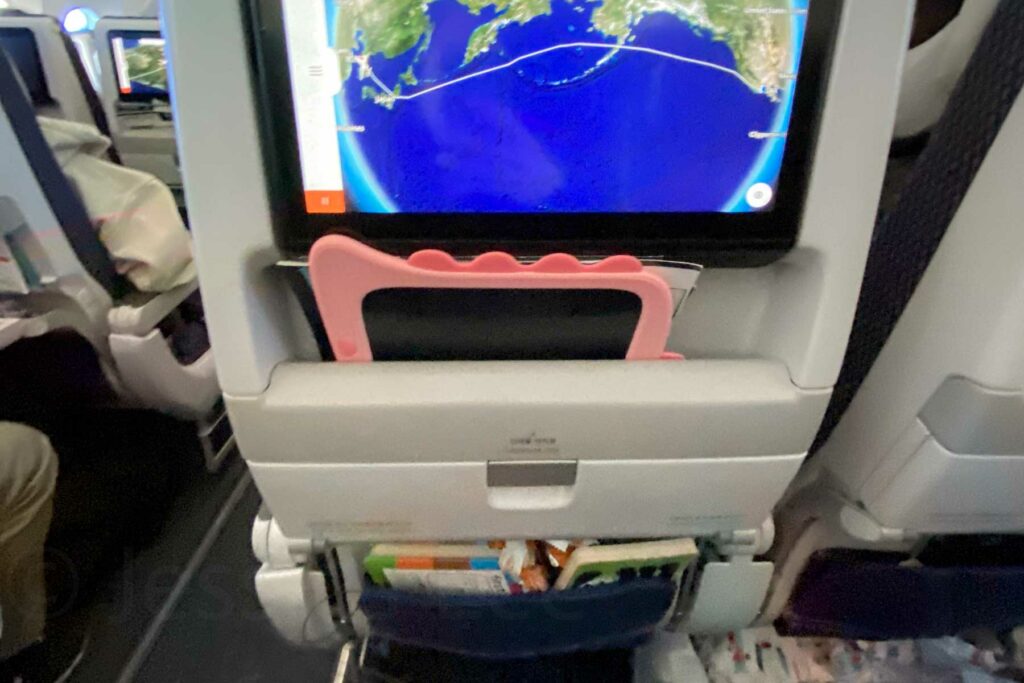
Take a stroll
Don’t be afraid to get up with your baby. It’s okay to walk up and down the aisles and do some loops to give your baby a change of pace. Planes for long haul flights are larger and often have two aisles with a little bit more space to move about.
It’s not healthy for anyone to sit still in one position for 10+ hours. So it is normal for everyone to get up and move around a bit on long-haul flights.
Ask for meals to be delivered separately
Airplane seats are tight, and even tighter if your baby is sitting on your lap. And buklhead or bassinet seat rows typically have the armrest fold-out trays which are usually smaller. This might make it difficult to eat.
Consider asking the flight attendants to only deliver one adult’s meal and have them eat first, while the other adult holds the baby. Then switch and ask for the other meal.
Change for nighttime
When you want your baby to sleep for nighttime, not only a nap, change them into pajamas and a sleep sack. Introduce other sleep routine items to cue them in.
Let people help
If others offer you help, take it! This could be something as big as someone else willing to walk your baby up and down the aisles. Or could be something smaller like someone smiling and playing peekaboo with your baby across the aisle.
I had a tougher time letting go and allowing others to help as a first time mom, but the second time around I learned quick. Random strangers have amused, distracted and calmed our baby more than once. If they’re offering, they mean well and want to help.
5. Tips for Troubleshooting Tears
Babies cry. It’s okay if your baby cries on your long flight. If they’re having a tough time and you need new ideas, consider these extra tips to help calm them down.
Use your baby carrier onboard
There is a lot of stimulation for babies on an airplane. Some babies shut down and sleep easily with excess stimulation, and others like mine are further energized by it.
When my oldest was younger, I found if I popped him in the baby carrier and put the headrest clip up (horse blinders), he would calm down and fall asleep. A carrier can also be helpful to walk the aisles with your baby, offering them a distraction but giving your arms a rest.
Hang out with the flight attendants
If the seat belt sign is off, and the flight attendants are not actively working through a meal or snack service, head to near the galley area (long haul planes usually have more than 1) and hang out with the flight attendants for a bit.
Of course, be respectful and stay out of the way. However the galley areas have more space, and flight attendants are used to parents and other passengers standing around nearby to get a break from their seats.
Some flight attendants love to interact with babies which can be a welcome distraction, use this to your advantage. In other situations, just the slightly different environment and more space from your seat can help break up the flight.
Try the restroom
When all else fails, I’ve brought my baby into the restroom. Something about the change of environment, extra bright lights, mirrors, and different noises seem to work. Let them run their hands under the water.
Pop into the restroom to try for a reset if your baby is having a tough time.

Check your expectations and breathe
I know it’s hard and might be exhausting, but if things aren’t going well or how you hoped, pause and check your expectations.
Are they realistic for a baby? Are they realistic for your baby considering the circumstances? Surviving a long haul flight can be tough for adults, a baby might not have the easiest time either.
Take a moment, close your eyes, and breathe. If you are traveling with someone else, hand them the baby and take a moment to yourself to breathe and reset.
Last Long Haul Logic
Bringing a baby on a 12 hour flight is a lot to take on. Some parents don’t have a choice and have to travel on a long flight for a move, work, or a family matter.
Other times parents choose to take their baby to a faraway place because they want to show their baby the world. It’s not the easiest thing to do, but it is doable, and you can do it. And for those parents where travel feeds your soul, it’s worth any airplane struggles.
I won’t tell you long haul flights with a baby are easy, they are not. Some babies have a more easy-going temperament and it may be easier for them. For others, it’s far more challenging, and for most, there are highs and lows. But this is life with a baby every day and everywhere.
Understanding the process, having realistic expectations, planning, and packing appropriately help. Adjusting your mindset, having realistic expectations, and taking it all in stride will improve your flight experience.
Keep this guide handy, save it, pin it, or email it to yourself (see the handy buttons just below). Refer back to this as you’re planning your big trip, packing, and trying to figure out how to master a long haul flight with a baby. Don’t forget to breathe!

